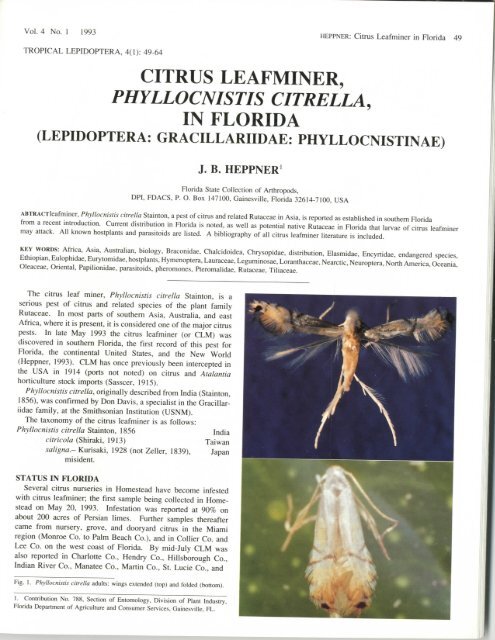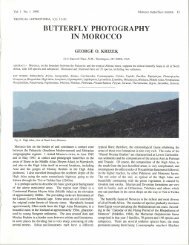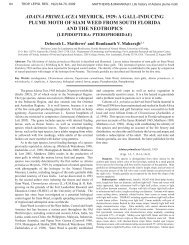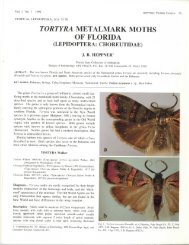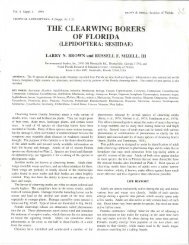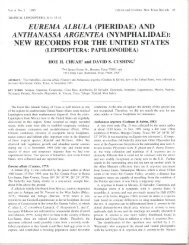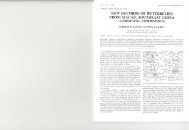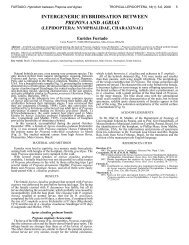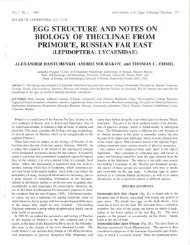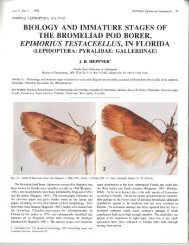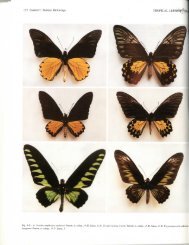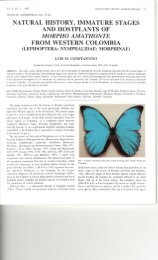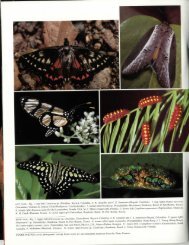CITRUS LEAFMINER, PHYLLOCNISTIS CITRELLA, IN FLORIDA
CITRUS LEAFMINER, PHYLLOCNISTIS CITRELLA, IN FLORIDA
CITRUS LEAFMINER, PHYLLOCNISTIS CITRELLA, IN FLORIDA
Create successful ePaper yourself
Turn your PDF publications into a flip-book with our unique Google optimized e-Paper software.
Vol. 4 No. 1 1993 HEPPNER: Citrus Leafminer in Florida 49<br />
TROPICAL LEPIDOPTERA, 4(1): 49-64<br />
<strong>CITRUS</strong> <strong>LEAFM<strong>IN</strong>ER</strong>,<br />
<strong>PHYLLOCNISTIS</strong> <strong>CITRELLA</strong>,<br />
<strong>IN</strong> <strong>FLORIDA</strong><br />
(LEPIDOPTERA: GRACILLARIIDAE: PHYLLOCNIST<strong>IN</strong>AE)<br />
J. B. HEPPNER1<br />
Florida State Collection of Arthropods,<br />
DPI, FDACS, P. O. Box 147100, Gainesville, Florida 32614-7100, USA<br />
ABTRACTleafminer, Phyllocnistis citrella Stainton, a pest of citrus and related Rutaceae in Asia, is reported as established in southern Florida<br />
from a recent introduction. Current distribution in Florida is noted, as well as potential native Rutaceae in Florida that larvae of citrus leafminer<br />
may attack. All known hostplants and parasitoids are listed. A bibliography of all citrus leafminer literature is included.<br />
KEY WORDS: Africa, Asia, Australian, biology, Braconidae, Chalcidoidea, Chrysopidae, distribution, Elasmidae, Encyrtidae, endangered species,<br />
Ethiopian, Eulophidae, Eurytomidae, hostplants, Hymenoptera, Lauraceae, Leguminosae, Loranthaceae, Nearctic, Neuroptera, North America, Oceania,<br />
Oleaceae, Oriental, Papilionidae, parasitoids, pheromones, Pteromalidae, Rutaceae, Tiliaceae.<br />
The citrus leaf miner, Phyllocnistis citrella Stainton, is a<br />
serious pest of citrus and related species of the plant family<br />
Rutaceae. In most parts of southern Asia, Australia, and east<br />
Africa, where it is present, it is considered one of the major citrus<br />
pests. In late May 1993 the citrus leafminer (or CLM) was<br />
discovered in southern Florida, the first record of this pest for<br />
Florida, the continental United States, and the New World<br />
(Heppner, 1993). CLM has once previously been intercepted in<br />
the USA in 1914 (ports not noted) on citrus and Atalantia<br />
horticulture stock imports (Sasscer, 1915).<br />
Phyllocnistis citrella, originally described from India (Stainton,<br />
1856), was confirmed by Don Davis, a specialist in the Gracillariidae<br />
family, at the Smithsonian Institution (USNM).<br />
The taxonomy of the citrus leafminer is as follows:<br />
Phyllocnistis citrella Stainton, 1856 India<br />
citricola (Shiraki, 1913) Taiwan<br />
saligna- Kurisaki, 1928 (not Teller, 1839), Japan<br />
misident.<br />
STATUS <strong>IN</strong> <strong>FLORIDA</strong><br />
Several citrus nurseries in Homestead have become infested<br />
with citrus leafminer; the first sample being collected in Homestead<br />
on May 20, 1993. Infestation was reported at 90% on<br />
about 200 acres of Persian limes. Further samples thereafter<br />
came from nursery, grove, and dooryard citrus in the Miami<br />
region (Monroe Co. to Palm Beach Co.), and in Collier Co. and<br />
Lee Co. on the west coast of Florida. By mid-July CLM was<br />
also reported in Charlotte Co., Hendry Co., Hillsborough Co.,<br />
Indian River Co., Manatee Co., Martin Co., St. Lucie Co., and<br />
Fig. 1. Phyllocnistis citrella adults: wings extended (top) and folded (bottom).<br />
1. Contribution No. 788, Section of Entomology, Division of Plant Industry,<br />
Florida Department of Agriculture and Consumer Services, Gainesville, FL.<br />
IB
50 HEPPNER: Citrus Leafminer in Florida TROPICAL LEPIDOPTE«<br />
Fig. 2. Phyllocnistis citrella adults, wings extended (top) and folded (bottom),<br />
(after Clausen, 1931, top; and Badawy, 1967, bottom) (line = 0.3mm)<br />
Orange Co. (see Fig. 3). Affected counties include the following<br />
(206 sites):<br />
Broward Co. (Coconut Creek, Cooper City, Davie, Ft. Lauderdale,<br />
Hallandale, Hollywood, Lauderdale Lakes, Miramar, Parkland,<br />
Pembroke Park, Pembroke Pines, Pompano Beach, Tamarac) — 38<br />
sites<br />
Charlotte Co. (Grove City) — 1 site<br />
Collier Co. (Immokalee, Marco Island, Naples, Sunniland) — 35 sites<br />
Dade Co. (Florida City, Goulds, Hialeah, Homestead, Medley, Miami,<br />
Miami Shores) — 98 sites<br />
Hendry Co. (Felda and LaBelle) — 2 sites<br />
Hillsborough Co. (Lithia, Ruskin, Tampa) — 3 sites<br />
Indian River Co. (Vero Beach) — 1 site<br />
Lee Co. (Bokeelia, Bonita Springs, Cape Coral, Estero, Ft. Myers,<br />
Pineland, St. James City, Sanibel) — 16 sites<br />
Manatee Co. (Bradenton) — 1 site<br />
Martin Co. (Hobe Sound) — 1 site<br />
Monroe Co. (Big Pine, Islamorada, Marathon, Tavernier) — 4 sites<br />
Orange Co. (Tangerine and Winter Park) — 2 sites<br />
Palm Beach Co. (Boca Raton, Delray Beach, Wellington) — 4 sites<br />
St. Lucie Co. (Ft. Pierce) — 1 site<br />
DISTRIBUTION OF CLM<br />
A widespread Asian species (Clausen, 1931, 1933; CIE, 1970,<br />
1986), described from Calcutta, India (Stainton, 1856), CLM now<br />
Fig. 3. Distribution in Florida as of mid-July 1993 (DPI range map).<br />
is known from East Africa — Sudan to Yemen (Badawy, 1967<br />
through southern Asia — Saudi Arabia to India (Fletcher, 192J<br />
and Indonesia (Kalshoven, 1981), north to Hong Kong and Chin!<br />
Philippines (Sasscer, 1915), Taiwan (Chiu, 1985; Lo and Chi!<br />
1988) and southern Japan (Clausen, 1927). It is also found i<br />
New Guinea and nearby Pacific Islands (CIE, 1970, 1986), an<br />
Australia (Beattie, 1989; Hill, 1918; Wilson, 1991). Reports ]<br />
CLM in South Africa are based on rearings from 1908 (Meyricl<br />
1909). The Ivory Coast and Nigeria records are relatively recei]<br />
(CIE, pers. comm.). The Australian introduction occurred befon<br />
1940 (possibly by 1918 according to Hill, 1918), and has sino<br />
1969 been reported from northern Queensland. Within 10 year<br />
it moved as far south as Sydney, NSW. The total knowi<br />
distribution is noted in Table 1.<br />
DIAGNOSIS<br />
Adults of the citrus leafminer are minute moths (4mm wing<br />
spread) with white and silvery iridescent scales on the forewings<br />
with several black markings and tan plus a black spot on ead<br />
wingtip (Fig. 1-2). The hind wings and body are white, with lon|<br />
fringe scales extending from the hindwing margins. In restin]<br />
pose with wings folded (Fig. 1-2), the moth is much smaller u
Vol. 4 No. 1 1993 HEPPNER: Citrus Leafminer in Florida 51<br />
TABLE 1. Distribution of Citrus Leafminer (in part after CIE, 1970, 1986).<br />
Nation<br />
NEW WORLD<br />
USA (Florida)<br />
AFRICA<br />
Ethiopia<br />
Ivory Coast<br />
Nigeria<br />
South Africa<br />
Sudan<br />
Tanzania<br />
ASIA<br />
Afghanistan<br />
Bangladesh<br />
China<br />
Hong Kong<br />
India<br />
Indonesia<br />
Iran<br />
Iraq<br />
Japan<br />
Kampuchea (Cambodia)<br />
Korea<br />
Laos<br />
Malaysia/Sarawak<br />
Myanmar (Burma)<br />
Nepal<br />
Pakistan<br />
Philippines<br />
Saudi Arabia<br />
Sri Lanka<br />
Taiwan<br />
Thailand<br />
Vietnam<br />
Yemen, North<br />
Yemen, South<br />
PACIFIC REGION<br />
Australia<br />
Caroline Is.<br />
Mariana Is.<br />
Papua New Guinea<br />
Solomon Is.<br />
Western Samoa<br />
Year<br />
1993<br />
1970<br />
1985?<br />
1988?<br />
1908?<br />
1962<br />
1972?<br />
origin?<br />
origin<br />
origin<br />
origin<br />
origin<br />
origin<br />
500 BC?<br />
500 BC?<br />
1600s?<br />
origin<br />
1600s?<br />
origin<br />
origin<br />
origin<br />
origin<br />
origin?<br />
1500s?<br />
100?<br />
origin<br />
1600s?<br />
origin<br />
origin<br />
1960?<br />
1960?<br />
1918?<br />
1952?<br />
1952?<br />
1953?<br />
1985?<br />
1982?<br />
References<br />
Heppner (1993)<br />
appearance (about 2mm). Many Phyllocnistis species are<br />
similar,with a smooth-scaled white head and a haustellum lacking<br />
basal scales, but CLM is easily detected on citrus by its meandering<br />
serpentine larval mine (Fig. 4-9), usually on the ventral side<br />
of the leaf. Larvae (Fig. 10) are minute (to 3mm), translucent<br />
greenish-yellow, and located inside the leaf mine; the last instar<br />
is a specialized prepupal non-feeding stage (Fig. 11). The pupa<br />
(Fig. 13-14) characteristically makes a pupal cell at the leaf<br />
margin. Adults are too minute to be easily noticed in the<br />
daytime, and have some activity at night as well.<br />
BIOLOGY<br />
The biology of CLM has been reported on by a number of<br />
researchers, including Badawy (1967), Beattie (1989), Clausen<br />
(1927, 1931, 1933), Fletcher (1920), Kalshoven (1981), Latif and<br />
CIE (1986)<br />
CIE (pers. comm.)<br />
CIE (pers. comm.)<br />
Meyrick (1909), Janse (1917), Vari & Kroon (1986)<br />
Ba-Angood (1977), Badawy (1968, [1969]), Schmutterer (1969), Siddig (1984)<br />
Bohlen (1973)<br />
Cotterell (1954), Giorbelidze (1979), Millet (1964)<br />
Alametal. (1965)<br />
Chekiang Univ. (1964), Chen & Wong (1936)<br />
Hill et al. (1982), Lee & Winney (1981), Mason & So (1969)<br />
Fletcher (1914, 1920), Stainton (1856)<br />
Hall (1925), Kalshoven (1950, 1981), Snellen (1903), Voute (1932, 1934)<br />
Farahbakhsh (1961), Gentry (1965)<br />
Gentry (1965)<br />
Esaki et al. (1932), Shiraki (1913)<br />
Hanson (1963b)<br />
Paik (1958)<br />
Manser et al. (1968)<br />
Dammerman (1929), Wallace (1966)<br />
Ghosh (1923, 1940), Hanson (1963a)<br />
Rana & Sharma (1965)<br />
Brooks (1958)<br />
Baltazar (1968)<br />
Ayoub (1960), FAO (1972)<br />
Rajapakse & Kulasekera (1982)<br />
Lo & Chiu (1988), Shiraki (1913)<br />
Thailand Dept. Agric. (1965)<br />
Logvinovskaya (1983), Whittle (1992)<br />
Cook (1988)<br />
Ba-Angood (1978), Mahfood (1968)<br />
Beattie (1989), Hill (1918), Turner (1940)<br />
Oakley (1953)<br />
Oakley (1953)<br />
Dumbleton (1954), Thomas (1962)<br />
Cffi (1986)<br />
Maddison (1986)<br />
Yunus (1951). Eggs of CLM are laid singly on the underside of<br />
host leaves. Egg eclosion occurs within 2-10 days, whereupon<br />
larvae immediately enter the leaf and begin feeding. Larvae<br />
make serpentine mines on young leaves (sometimes also young<br />
shoots), resulting in leaf curling and serious injury. Leaf mines<br />
are usually on the ventral leaf surface, except in heavy infestations<br />
when both leaf surfaces are used. Usually only one leaf<br />
mine is present per leaf but heavy infestations can have 2 or 3<br />
mines per leaf; up to 9 mines on large leaves have been found in<br />
Florida and up to 20 mines per leaf are known from elephant<br />
lemon in India (Pandey and Pandey, 1964). As with similar<br />
leafminers, larvae are protected within the leaf during their<br />
feeding cycle. Larvae have 4 instars (or 3 instars and the specialized<br />
prepupal stage, Fig. 11). Development time takes from<br />
5-20 days. Pupation is within the mine in a special pupal cell at
52 HEPPNER: Citrus Leafminer in Florida TROPICAL LEPIDOPTEJ<br />
Fig. 4-9. Leaf mines of citrus leafminer (various Citrus sp. from southern Florida): 4-6. Normal mines on ventral leaf surfaces; 7-9. Irregular mines on dorsal le<br />
surfaces, (photo credits: Jeffrey W. Lotz, DPI)<br />
the leaf margin, under a slight curl of the leaf; rarely this can<br />
occur in a depression of the leaf surface away from the margin.<br />
Adults emerge about dawn and are active in the morning; other<br />
activity is at dusk or night. Females lay eggs evenings and at<br />
night (Badawy, 1967; Beattie, 1989; Pandey and Pandey, 1964).<br />
Generations per year appear to be nearly continuous: 6-10 in<br />
southern Japan (Clausen, 1931), 9-13 in northcentral India (Lai,<br />
1950); 10 in southern India (Pandey and Pandey, 1964). Development<br />
time is reported as follows: 2-10 days for egg hatching;<br />
5-20 days for larval development (4 instars are needed, or 3 pli<br />
the prepupal stage); and 6-22 days for pupal developmen<br />
totalling a generation time of about 13-52 days (Pandey at<br />
Pandey, 1964; Voute, 1934, 1935), depending on weather at<br />
temperature conditions. Adults live for only a few days, or abo<br />
1 week on average.<br />
CLM appears to help spread citrus canker (Hill, 1918; Ando<br />
a/., 1985) because of leaf damage from the mine, whereupon tl<br />
citrus canker can gain easy entrance to internal tissues of the le£
Vol. 4 No. 1 1993 HEPPNER: Citrus Leafminer in Florida 53<br />
11<br />
Fig. 10-14. Immature stages of Phyllocnistis citrella: 10. Last instar larva; 11. Prepupal stage; 12. Detail of larval mandible; 13. Pupa (front view); 14. Detail of pupal<br />
head sculpture (lateral view), (after Clausen, 1931) [all greatly enlarged]<br />
14
54 HEPPNER: Citrus Leafminer in Florida TROPICAL LEPIDOF<br />
TABLE 2. Recorded hostplants of Citrus Leafminer (* unsuitable hosts (larvae do not complete development); A Florida recc<br />
RUTACEAE<br />
Aegle marmelos<br />
Atalantia sp.<br />
AX Citrofortunella sp.<br />
AX Citrofortunella microcarpa<br />
Adtrus sp.<br />
Adtrus aurantiifolia<br />
Adtrus aurantiifolia [='Swingle']<br />
Adtrus aurantiifolia 'Tahiti'<br />
Adtrus aurantium<br />
Citrus jambhiri<br />
Citrus latifolia<br />
Citrus limetta<br />
Citrus limettioides<br />
Adtrus limon<br />
Citrus limon [= var. pusilla]<br />
Citrus x limonia<br />
Citrus x limonia [?= Citrus nakoor]<br />
Adtrus maxima<br />
Citrus maxima 'Kao pan'<br />
Citrus maxima [= grandis]<br />
Citrus medica<br />
Adtrus meyeri [='Meyer']<br />
Citrus myrtifolia<br />
Citrus x nobilis<br />
Adtrus x nobilis 'Temple'<br />
Adtrus x parodist<br />
Adtrus reticulata<br />
Citrus reticulata [= deliciosa]<br />
Citrus reticulata [= kara]<br />
Citrus reticulata [= reshni]<br />
Citrus reticulata [= suhuiensis]<br />
Citrus rugulosa<br />
Adtrus sinensis<br />
bael tree<br />
limequat<br />
calamondin<br />
citrus<br />
lime<br />
Key lime<br />
Persian lime<br />
sour orange/bigarade<br />
rough lemon<br />
seedless lime<br />
sweet lime<br />
sweet lime<br />
lemon<br />
Rangpur lemon<br />
Nakoor lemon<br />
pummelo<br />
Siamese pummelo<br />
shaddock<br />
citron/elephant lemon<br />
Meyer lemon<br />
chinotto<br />
tangor/king mandarin<br />
Temple tangor<br />
grapefruit<br />
tangerine/mandarin<br />
Mediterranean mandarin<br />
Kara mandarin<br />
Cleopatra mandarin<br />
Murcott mandarin<br />
sweet orange<br />
China (Huang et al., 1989a)<br />
India (Fletcher, 1920)<br />
Philippines (Sasscer, 1915)<br />
Florida (DPI report) New Host Record<br />
Florida (DPI report) New Host Record<br />
Florida (DPI report)<br />
India (Stainton, 1856)<br />
Florida (DPI report)<br />
India (Latif & Yunus, 1951)<br />
Sudan (Badawy, 1967)<br />
Florida (DPI report) New Host Record<br />
Florida (DPI report)<br />
Florida (DPI report)<br />
India (Latif & Yunus, 1951)<br />
Saudi Arabia (Ayoub, 1960)<br />
Sudan (Badawy, 1967)<br />
India (Verma & Sohi, 1968; Singh & Rao, 1978)<br />
India (Singh & Rao, 1978)<br />
India (Latif & Yunus, 1951; Pandey & Pandey, 1964<br />
Sudan (Badawy, 1967)<br />
India (Singh et al., 1989)<br />
Florida (DPI report)<br />
Australia (Wilson, 1991)<br />
India (Pruthi & Mani, 1945; Singh & Rao, 1978)<br />
Saudi Arabia (Ayoub, 1960)<br />
India (Latif & Yunus, 1951; Singh & Rao, 1978;<br />
Batra et al., 1988<br />
India (Singh & Rao, 1978)<br />
Florida (DPI report)<br />
Hong Kong (Lee & Winney, 1981)<br />
India (Pruthi & Mani, 1945; Latif & Yunus, 1951;<br />
Pandey & Pandey, 1964)<br />
Vietnam (Whittle, 1992)<br />
Philippines (Reinking & Groff, 1921)<br />
India (Singh et al., 1989)<br />
India (Latif & Yunus, 1951; Pandey & Pandey, 1964<br />
Saudi Arabia (Ayoub, 1960)<br />
Florida (DPI report) New Host Record<br />
Saudi Arabia (Ayoub, 1960)<br />
India (Latif & Yunus, 1951; Singh et al., 1989)<br />
Sudan (Badawy, 1967)<br />
Florida (DPI report) New Host Record<br />
Florida (DPI report)<br />
Australia (Wilson, 1991)<br />
Hong Kong (Lee & Winney, 1981)<br />
India (Latif & Yunus, 1951)<br />
Sudan (Badawy, 1967)<br />
Florida (DPI report)<br />
Hong Kong (Lee & Winney, 1981)<br />
India (Singh & Rao, 1978; Singh et al., 1989)<br />
Korea (Catling et al., 1977)<br />
Saudi Arabia (Ayoub, 1960)<br />
India (Singh & Rao, 1978)<br />
India (Singh & Rao, 1978; Batra et al., 1988)<br />
Vietnam (Whittle, 1992)<br />
India (Singh et al., 1989)<br />
Florida (DPI report)<br />
China (Huang et al., 1989a)<br />
India (Mitra & Khongwir, 1928; Pruthi & Mani, 194<br />
Latif & Yunus, 1951; Pandey & Pandey, 1964;<br />
et al., 1989)
Vol. 4 No. 1 1993 HEPPNER: Citrus Leafminer in Florida 55<br />
Adtrus sinensis 'Sunburst'<br />
Adtrus sinensis 'Valencia'<br />
Adtrus x tangelo<br />
Adtrus x tangelo 'Minneola'<br />
Citrus reticulata 'Owari Satsuma' [= unshiu]<br />
AFortunella crassifolia<br />
Fortunella margarita<br />
Limonia spp.<br />
Murraya paniculata<br />
*Murraya koenigii<br />
Poncirus trifoliata<br />
Rutaceae spp.<br />
Severinia buxifolia<br />
OLEACEAE<br />
*Jasminum sp.<br />
*Jasminum cinnamomifolium<br />
tJasminum humile<br />
Jasminum sambac<br />
LORANTHACEAE<br />
Loranthus sp. [on citrus]<br />
LEGUM<strong>IN</strong>OSAE<br />
*Dalbergia sissoo<br />
Pongamia pinnata<br />
LAURACEAE<br />
Alseodaphne semecarpifolia<br />
Cinnamomum zeylanicum<br />
TILIACEAE<br />
*Grewia asiatica<br />
sunburst orange<br />
Valencia orange<br />
tangelo<br />
Minneola tangelo<br />
satsuma<br />
kumquat<br />
kumquat<br />
wood apple<br />
orange jasmine<br />
curry leaf<br />
trifoliate orange<br />
Chinese box orange<br />
jasmine<br />
yellow jasmine<br />
Arabian jasmine/bela<br />
mistletoe<br />
sissoo<br />
karum tree<br />
cinnamon<br />
A sex attractant for males of CLM has been reported by Ando<br />
et al. (1985): (7Z, HZ)-7,ll-hexadecadienal in Japan. Further<br />
studies with this pheromone have been conducted by Ujiye (1990,<br />
1992), and by Narahara and Kai (1991), in Japan.<br />
HOSTPLANTS<br />
CLM is common on species of citrus and related Rutaceae<br />
within its range (Kalshoven 1981). CLM is most commonly<br />
found on leaves of grapefruit and pummelo (pomelo) (Badawy,<br />
1967). In Florida, CLM has been found most commonly on<br />
Persian and Key limes, and on grapefruit, although most all citrus<br />
commonly grown in Florida has harbored CLM.<br />
Recorded Rutaceae outside of Florida include Aegle marmelos<br />
in India (Fletcher, 1920), Atalantia sp. in the Philippines (Sasscer,<br />
1915), Murraya exotica in India (Pruthi and Mani, 1945),<br />
Poncirus trifoliata in India (Clausen, 1933), and various native<br />
Rutaceae in Indonesia (Kalshoven, 1981). Other reported hosts<br />
include Jasminum sambac (Oleaceae) in India (Fletcher, 1920),<br />
mistletoes on citrus (Loranthus sp., Loranthaceae) in the<br />
Philippines (Reinking and Groff, 1921), Pongamia pinnata<br />
(Leguminosae) in India (Margabandhu, 1933), and Alseodaphne<br />
semecarpifolia (Lauraceae) in India (Latif and Yunus, 1951).<br />
Florida records include various Citrus sp., kumquat (Fortunella<br />
Sudan (Badawy, 1967)<br />
Florida (DPI report)<br />
Florida (DPI report)<br />
Florida (DPI report) New Host Record<br />
Florida (DPI report) New Host Record<br />
India (Singh & Rao, 1978)<br />
Florida (DPI report) New Host Record<br />
Saudi Arabia (Ayoub, 1960)<br />
India (Sandhu & Batra, 1978)<br />
India (Pruthi & Mani, 1945)<br />
India (Fletcher, 1920; Margabandhu, 1933;<br />
Pruthi & Mani, 1945)<br />
India (Clausen, 1933; Singh & Rao, 1978; Singh etal., 1989)<br />
Indonesia (Voute, 1934, 1935)<br />
India (Sandhu & Batra, 1978)<br />
India (Margabanhu, 1933)<br />
India (Pruthi & Mani, 1945)<br />
Florida (DPI report) New Host Record<br />
India (Fletcher, 1920)<br />
Saudi Arabia (Ayoub, 1960)<br />
Philippines (Sasscer, 1915; Reinking & Groff, 1921)<br />
Thailand (Clausen, 1931)<br />
India (Latif & Yunus, 1951)<br />
India (Margabandhu, 1933)<br />
India (Latif & Yunus, 1951)<br />
Sri Lanka (Rajapakse & Kulasekera, 1982)<br />
India (Latif & Yunus, 1951)<br />
crassifolia), and calamondin (\Citrofortunella microcarpa).<br />
Several other hosts have been reported for CLM but larvae do<br />
not complete their life cycle on these incompatible hosts:<br />
Murraya koenigii (Rutaceae) in India (Fletcher, 1920), Jasminum<br />
sp. and Jasminum cinnamomifolium (Oleaceae) in India (Pruthi<br />
and Mani, 1945), Dalbergia sissoo (Leguminosae) in India (Latif<br />
and Yunus, 1951), and Grewia asiatica (Tiliaceae) in India (Latif<br />
and Yunus, 1951). A Salix sp. (Salicaceae) host record for India<br />
(Pruthi and Mani, 1945) probably refers to the related Phyllocnistis<br />
saligna (Zeller), which feeds on willow. Table 2 summarizes<br />
known hostplant data for CLM (numerous minor cultivars<br />
of Citrus spp. have also been reported as hosts for CLM; see<br />
Sinha, Batra, and Uppal, 1972).<br />
PARASITES<br />
A number of workers in various countries have discovered<br />
parasitoids of CLM over the years. Table 3 lists all known<br />
parasitoids recorded thus far for CLM, a total of 39 species in 7<br />
families, mostly Chalcidoidea. Several species of parasitoids<br />
have been reared from CLM in Florida but results are not in yet<br />
as to whether these are native Florida species or also imported<br />
along with CLM. So far no Diptera have been reported parasitizing<br />
CLM larvae.
56 HEPPNER: Citrus Leafminer in Florida TROPICAL LEPIDOPTH<br />
TABLE 3. Parasites Recorded from Citrus Leafminer.<br />
BRACONIDAE<br />
Bracon sp.<br />
Microbracon phyllocnistidis Muesebeck, 1933<br />
CHALCIDOIDEA<br />
sp.?<br />
ELASMIDAE<br />
Elasmus sp.<br />
Elasmus zehntneri Ferriere, 1929<br />
ENCYRTIDAE<br />
Ageniaspis sp.<br />
Ageniaspis sp.<br />
Ageniaspis sp.<br />
Ageniaspis citricola Logvinovskaya, 1983<br />
EULOPHIDAE<br />
Ascotolinx funeralis Girault, 1913a<br />
Chrysocharis sp.<br />
Chrysonotomyia sp.<br />
Citrosticus phyllocnistoides (Narayanan, 1960)<br />
Cirrospilus sp.<br />
Cirrospilus ingennus Gahan, 1932<br />
Cirrospilus phyllocnistis (Ishii, 1953)<br />
Cirrospilus quadristriatus (Rao & Ramamani, 1966)<br />
Closterocerus trifasciatus Westwood, 1833<br />
Holcopelte sp.<br />
Kratosysma sp.<br />
Kratosysma citri Boucek, 1988<br />
Pleurotroppopsis sp.<br />
Pnigalio sp.<br />
Semielacher sp.<br />
Semielacher petiolatus (Girault, 1915)<br />
Stenomesius japonicus (Ashmead, 1904)<br />
Sympiesis sp.<br />
Sympiesis sp.<br />
Sympiesis striatipes (Ashmead, 1904)<br />
Teleopterus sp.<br />
Tetrastichus sp. A<br />
Tetrastichus sp. B<br />
Tetrastichus sp.<br />
Tetrastichus sp.<br />
Zaommomentedon brevipetiolatus Kamijo, 1990<br />
EURYTOMIDAE<br />
Eurytoma sp.<br />
Eurytoma sp.<br />
PTEROMALIDAE<br />
Asaphoideus niger Girault, 1913b<br />
sp? (Pirenini)<br />
Philippines (Baroga, 1968)<br />
Indonesia (Muesebeck, 1933)<br />
Sri Lanka (Rutherford, 1914)<br />
Japan (Ujiye, 1988)<br />
Indonesia (Ferriere, 1929)<br />
Philippines (Baroga, 1968)<br />
Indonesia (Voute, 1934, 1935)<br />
Saudi Arabia (Ayoub, 1960)<br />
Thailand (Ujiye & Morakote, 1992)<br />
Taiwan (Lo & Chiu, 1988)<br />
Vietnam (Logvinovskaya, 1983)<br />
Australia (Boucek, 1988)<br />
Japan (Ujiye, 1988)<br />
Japan (Ujiye, 1988)<br />
India (Rao & Ramamani, 1966; Boucek, 1988)<br />
Thailand (Ujiye & Morakote, 1992)<br />
Japan (Ujiye, 1988)<br />
Taiwan (Lo & Chiu, 1988)<br />
Japan (Ishii, 1953; Ujiye, 1988)<br />
Taiwan (Wu & Tao, 1977)<br />
India (Rao & Ramamani, 1966)<br />
Thailand (Ujiye & Morakote, 1992)<br />
Japan (Ujiye, 1988)<br />
Thailand (Ujiye & Morakote, 1992)<br />
Japan (Ujiye, 1988)<br />
Thailand (Ujiye & Morakote, 1992)<br />
Papua New Guinea (Boucek, 1988)<br />
Japan (Ujiye, 1988 [as Cotterellia sp.])<br />
Japan (Ujiye, 1988)<br />
Papua New Guinea (Boucek, 1988)<br />
Australia (D. Smith, pers. comm.; Boucek, 1988)<br />
Japan (Kamijo, 1976 [= Sympiesomorpha mikan Ishii, 1953])<br />
Taiwan (Wu & Tao, 1977)<br />
Australia (D. Smith, pers. comm.)<br />
Taiwan (Wu & Tao, 1977)<br />
Japan (Ujiye, 1988)<br />
Thailand (Ujiye & Morakote, 1992)<br />
Thailand (Ujiye & Morakote, 1992)<br />
Japan (Ujiye, 1988)<br />
Japan (Ujiye, 1988)<br />
Taiwan (Lo & Chiu, 1988)<br />
Thailand (Ujiye & Morakote, 1992)<br />
Japan (Ujiye, 1988 [as Visnuella sp.])<br />
Thailand (Ujiye & Morakote, 1992)<br />
Sri Lanka (Hutson & Pinto, 1934)<br />
Thailand (Ujiye & Morakote, 1992)<br />
Australia (Boucek, 1988)<br />
Philippines (Baroga, 1968)
Vol. 4 No. 1 1993 HEPPNER: Citrus Leafminer in Florida 57<br />
IMPACT <strong>IN</strong> <strong>FLORIDA</strong><br />
CLM has the potential of rapidly spreading throughout citrus<br />
areas of Florida (note spread in Australia from Queensland to<br />
Sydney in only a few years). Attacks on young trees can kill<br />
plants; older citrus would sustain damage to new leaves during<br />
leaf flush. CLM may also attack native mistletoes (Loranthaceae)<br />
in Florida as new hosts. Citrus fruit is not damaged by CLM nor<br />
directly affected.<br />
CLM potentially could spread throughout the southeast U.S. if<br />
native Rutaceae are found to its liking; cold winters would limit<br />
its spread north about to Georgia, if the distribution in China is<br />
any indication. Other ornamentals and native Rutaceae are<br />
potential hosts or occur in Florida in horticultural plantings (e.g.,<br />
mock orange), including such plants as wild lime, the hostplant<br />
of the endangered Schaus swallowtail butterfly in the Florida<br />
Keys. Potential native Rutaceae (plus some introduced species)<br />
found in Florida are noted in Table 4.<br />
CLM is thought to help spread citrus canker (Hill, 1918; Ando<br />
et al., 1985) because of leaf damage from the mine; research in<br />
India has shown a 50% increase in citrus canker in groves<br />
infested with CLM (Sohi and Sandhu, 1968).<br />
Control of CLM in Florida is anticipated to include a spray<br />
regime of various pesticides as is done in other countries (see<br />
economic papers in Bibliography). Biological control measures<br />
with various parasitoids of CLM also should be effective in<br />
reducing populations of CLM. One predator is known from<br />
China, Chrysopa boninensis Okamato (Neuroptera: Chrysopidae),<br />
one of the green lacewings (Huang et al., 1989a). The pheromone<br />
for CLM also has the potential to help monitor adult<br />
populations, and possibly even reduce their numbers when used<br />
in combination with a sesiid-type sticky trap (Ujiye, 1990).<br />
TABLE 4. Potential Hostplants in Florida.<br />
Amyris balsamifera<br />
Amyris elemifera<br />
Atalantia ceylanica<br />
Casimiroa edulis<br />
Citroncirus webberi<br />
Citrofortunella microcarpa<br />
Citrus spp.<br />
Dictamnus albus<br />
Fortunella crassifolia<br />
Glycosmis parviflora<br />
Limonia acidissima<br />
Murraya spp.<br />
Poncirus trifoliata<br />
Ptelea trifoliata<br />
Ruta graveolens<br />
Severinia buxifolia<br />
Severinia monophylla<br />
Thamnosma texana<br />
Triphasia trifolia<br />
Zanthoxylum americanum<br />
Zanthoxylum clava-herculis<br />
Zanthoxylum coriaceum<br />
*Zanthoxylum fagara<br />
Zanthoxylum flavum<br />
balsam torchwood<br />
torchwood<br />
white sapote<br />
citrange<br />
calamondin<br />
citrus (all species)<br />
gas plant<br />
kumquat<br />
Chinese glycosmis<br />
wood apple<br />
mock oranges<br />
trifoliate orange<br />
stinking ash/hoptree<br />
common rue<br />
Chinese box orange<br />
Texas turpentine broom<br />
limeberry<br />
northern prickly ash<br />
Hercules' club<br />
Biscayne prickly ash<br />
wild lime<br />
satinwood/yellowwood<br />
oviposition by CLM S recorded in Florida (J. Pena, pers. comm.)<br />
ACKNOWLEDGMENTS<br />
The staff of the Division of Plant Industry, particularly the<br />
many dedicated plant inspectors for Florida, are to be thanked for<br />
locating this citrus pest and helping to document its spread. The<br />
DPI Library staff are thanked for their efforts in securing many<br />
of the more obscure publications noted in the bibliography,<br />
although not all could be seen prior to this publication. Jeffrey<br />
W. Lotz, DPI photographer, is thanked for the photographs<br />
included herein. Wayne Dixon, Biological Administrator, is<br />
especially thanked for spearheading the effort to document this<br />
pest and its occurence in Florida. Nancy Coile, DPI staff Botanist,<br />
provided considerable help in correcting botanical names,<br />
particularly the complex synonymy of the many species and<br />
cultivars of Citrus. Dan Smith, of Nambour, Queensland,<br />
Australia, kindly noted parasitoids being used in Australia against<br />
CLM. Jorge Pena, IFAS Subtropical Research and Education<br />
Center, University of Florida, Homestead, FL, is thanked for<br />
beginning hostplant testing of CLM on native Florida plants.
58 HEPPNER: Citrus Leafminer in Florida TROPICAL LEPIDOPTE<br />
TAXONOMY<br />
Common, I. F. B.<br />
1990. Moths of Australia. Melbourne: Melbourne Univ. Pr. 535pp,<br />
32pl.<br />
Davis, D. R.<br />
1987. Gracillariidae (Tineoidea). In F. W. Stehr (ed.), Immature<br />
insects [1], 372-378. Dubuque: Kendall/Hunt Publ. Co.<br />
Esaki, T., et al.<br />
1932. Iconographia insectorum japonicorum. Tokyo: Hokuryukan.<br />
2500pp, 24pl. [In Japanese]<br />
1957-58. Icones heterocerorum japonicorum in coloribus naturalibus.<br />
Osaka: Hoikusha. 2 v. [In Japanese]<br />
Heppner, J. B., and H. Inoue (eds.)<br />
1992. Lepidoptera of Taiwan. Vol. 1, Part 2: Checklist. Gainesville:<br />
Assoc. Trop. Lepid. 276pp.<br />
Inoue, H., et al<br />
1953-61. Check list of the Lepidoptera of Japan. Tokyo. 6 pts<br />
(683pp). [In Japanese]<br />
Inoue, H., T. Okano, T. Shirozu, S. Sugi, and H. Yamamoto<br />
1959. Iconographia insectorum japonicorum colore naturali edita.<br />
Tokyo. Vol. 1. 284+67+40pp, 184pl. [In Japanese]<br />
Inoue, H., S. Sugi, H. Kuroko, S. Moriuti. and A. Kawabe<br />
1982. Moths of Japan. Tokyo: Kodansha. 2 vol. [In Japanese]<br />
Issiki, S., et al.<br />
1965. Early stages of Japanese moths in colour. Osaka: Hoikusha.<br />
Vol. 1. 237pp, 60pl. (1979 reprint) [in Japanese]<br />
Janse, A. J. T.<br />
1917. Check-list of the South African Lepidoptera Heterocera.<br />
Pretoria. 219pp.<br />
Meyrick, E.<br />
1909. New South African Microlepidoptera. Ann. S. African Mus.<br />
(Pretoria), 5:349-379.<br />
Park, K. T.<br />
1983. Microlepidoptera of Korea. Insecta Koreana (Chuncheon),<br />
3:1-195, 2pl.<br />
Seksjeva, S. V.<br />
1981. 25. Fam. Phyllocnistidae. In Identification keys to the insects<br />
of European Russia. Vol. 4. Lepidoptera. Pt. 2, 311-313.<br />
Moscow.<br />
Shiu, Y. H., K. T. Park, and S. H. Nam<br />
1983. Illustrated Flora & Fauna of Korea. Vol.27. Insecta (IX).<br />
Lepidoptera. Seoul. 1053pp, 48pl.<br />
Snellen, P. C. T.<br />
1903. 7. Phyllocnistis minutella Snellen i 1., nov. sp. In W. van<br />
Deventer, Over de ontwikkelingstoestanden van eenige<br />
Microlepidoptera van Java. Tijds. Ent. (Amsterdam), 46:87-89,<br />
pi. 10.<br />
Stainton, H. T.<br />
1856. Descriptions of three species of Indian Micro-Lepidoptera.<br />
Trans. Ent. Soc. London, (n.s.) 3:301-304.<br />
Turner, A. J.<br />
1940. A revision of the Australian Gracilariidae (Lepidoptera).<br />
Trans. Roy. Ent. Soc. S. Austr. (Adelaide), 64:50-69.<br />
Vari, L., and D. Kroon<br />
1986. Southern African Lepidoptera: a series of cross-referenced<br />
indices. Pretoria: Transvaal Mus. 198pp.<br />
Wang, P. Y., et al.<br />
1981. Iconographia heterocerorum sinicorum. Beijing: Acad. Sinica.<br />
4v.<br />
<strong>CITRUS</strong> <strong>LEAFM<strong>IN</strong>ER</strong> BIBLIOGRAPHY<br />
BIOLOGY<br />
Anon.<br />
1959. Illustrated insect larvae of Japan. Tokyo: Hokuryu<br />
714pp.<br />
Ba-Angood, S. A. S.<br />
1977. A contribution to the biology and occurrence of the<br />
leafminer, Phyllocnistis citrella Staint., in the Sudan. 2<br />
Angew. Ent. (Berlin), 83:106-111.<br />
1978. On the biology and food preference of the citrus leafmi<br />
Phyllocnistis citrella Stainton, in PDR of Yemen. Zeit. Ang<br />
Ent. (Berlin), 86:53-57.<br />
Badawy, A.<br />
[1969]. The morphology and biology of Phyllocnistis citrella Sta<br />
a citrus leaf-miner in the Sudan. Bull. Soc. Ent. Eg)<br />
(Cairo), 51:95-103 (1967).<br />
Barroga, S. F.<br />
1968. Biological notes and control of citrus leafminer (Phvllocni<br />
citrella Stainton) affecting citrus seedlings. Philipp. J. P<br />
Ind. (Manila), 33:17-29.<br />
Bhumannavar, B. S., and S. P. Singh<br />
1983. Studies on population dynamics of citrus leaf miner Phyll<br />
nistis citrella Stainton (Lepidoptera: Phyllocnistidae). E<br />
man. (Trivandrum), 8:397-400.<br />
Clausen, C. P.<br />
1931. Two citrus leaf miners of the Far East. USD A, Tech. I<br />
(Washington), 252:1-13.<br />
Deventer, W. van<br />
1903. Over de ontwikkelingstoestanden van eenige Microlepidop<br />
van Java. Tijds. Ent. (Amsterdam), 46:79-89, pi. 9-10.<br />
Fletcher, T. B.<br />
1914. Some south Indian insects. Madras: Govt. Pr. 565pp.<br />
1920. Life histories of Indian insects. Microlepidoptera. Mem.Dt<br />
Agric. India (New Delhi), 6:1-217, 68pl.<br />
Grandi, G.<br />
1951. Introduzione allo studio dell'entomologia. Vol. II. Endop<br />
igoti. Bologna: Ediz. Agricola. 1332pp.<br />
Hamamura. T.<br />
1980. Studies on the overwintering of the citrus leaf miner, Phylt<br />
nistis citrella Stainton (Lepidoptera: Lyonetiidae) in Hiro^<br />
ma. Kaju Shikenjo Hokoku Bull. Fruit Tree Res. Sta. (Akits<br />
Ser. E., 3:99-112.<br />
Bering, E. M.<br />
1951. Biology of the leaf miners. The Hague: W. Junk. 420pp.<br />
Hill, D. S., P. Hore, and I. W. B. Thornton<br />
1982. Insects of Hong Kong. Hong Kong: Hong Kong Univ.<br />
503pp.<br />
Huang, M. Z., and M. D. Huang<br />
1989. Study on the spatial pattern of larvae of Citrus leaf miner.<br />
Studies on the integrated management of Citrus insect pe-<br />
90-95. Guangzhou: Acad. Bk. & Periodical Pr. [In Chine)<br />
Hutson, J. C., and M. P. D. Pinto<br />
1934. Two caterpillar pests of citrus. Trop. Agric. (Peradeni)<br />
83:188-193, 2pl.<br />
Ikemoto, T.<br />
1972. Ecological studies on a field population of the citrus 1<br />
miner, Phyllocnistis citrella Stainton (Lepidoptera: Phyllocr<br />
tidae), with special reference to spatial distribution patK<br />
Japan. J. Appl. Ent. Zoo/. (Tokyo), 16:127-138.
Vol. 4 No. 1 1993 HEPPNER: Citrus Leafminer in Florida 59<br />
Kurisaki, M.<br />
1928. On the life-history of citrus leaf miner, Phyllocnistis saligna,<br />
Zell., and the relation between this miner and citrus canker,<br />
Pseudomonas citri, Hasse. Insect World (Gifu), 24:39-44. [In<br />
Japanese] [refers to P. citrella}<br />
Liu, S. K., and R. G. Zeng<br />
1981. Larval stages of the citrus leaf miner (Phyllocnistis citrella<br />
Stainton). J. S. China Agric. Univ. (Kuangchou), 2:51-57. [In<br />
Chinese]<br />
Lo, K. C., and S. C. Chiu<br />
1988. The illustrations of citrus insect pests and their natural<br />
enemies in Taiwan. Taichung: Taiwan Agric. Res. Inst. 75pp.<br />
[In Chinese]<br />
Needham, J. G., S. W. Frost, and B. H. Tothill<br />
1928. Leaf-mining insects. Baltimore: Williams & Wilkins. 351pp.<br />
Pandey, N. D., and Y. D. Pandey<br />
1964. Bionomics of Phyllocnistis citrella Stt. (Lepidoptera: Gracillariidae).<br />
Indian J. Ent. (New Delhi), 26:417-423.<br />
Radke, S. G., and H. G. Kandalkar<br />
1987. Bionomics of citrus leafminer, Phyllocnistis citrella Stainton<br />
(Lepidoptera: Gracillariidae). P.K.V. Res. J. (Akola), 11:91-<br />
92.<br />
Siddigi, M. S., and K. P. Mahur<br />
1981. Bionomics of citrus leafminer, Phyllocnistis citrella St. Prog.<br />
Hon. (Ranikhet), 13:55-64.<br />
Sohi, G. S., and G. C. Verma<br />
1966. Feeding habits of Phyllocnistis citrella Stainton in relation to<br />
the anatomical structure of the leaf. Indian J. Ent. (New<br />
Delhi), 27:483-485.<br />
Sontakay, K. R., and R. L. Gupta<br />
1945. Seasonal incidence of Phyllocnistis citrella Stt. The citrus leaf<br />
miner. Indian Farming (New Delhi), 1:106.<br />
Thailand Dept. Agric.<br />
1965. A host list of the insects of Thailand. Bangkok. 149pp.<br />
Yamamoto, E.<br />
1968. Studies on the biology and control of the citrus leaf miner,<br />
Phyllocnistis citrella Stainton. 1. On the biology. Proc.<br />
Assoc. Plant Prot. Kyushu (Fukuoka), 14:47-50. [In Japanese]<br />
1969. Studies on the biology and control of the citrus leaf miner,<br />
Phyllocnistis citrella Stainton. 2. On the ecology. Proc.<br />
Assoc. Plant Prot. Kyushu (Fukuoka), 15:158-160. [In Japanese]<br />
1971. Studies on the biology and control of the citrus leaf miner,<br />
Phyllocnistis citrella Stainton. 3. On the development. Proc.<br />
Assoc. Plant Prot. Kyushu (Fukuoka), 17:64-65. [In Japanese]<br />
PHEROMONES<br />
Ando, T., K. Y. Taguchi, M. Uchiyama, T. Ujiye, and H. Kuroko<br />
1985. (7Z-llZ)-7,ll-hexadecadienal: sex attractant of the citrus<br />
leafminer moth, Phyllocnistis citrella Stainton (Lepidoptera,<br />
Phyllocnistidae). Agric. Biol. Chem. Tokyo, 49:3633-3653.<br />
Du, T. Y., J. J. Xiong, and Z. H. Wang<br />
1989. (7Z, 1 lZ)-7, 11-hexadecadienal: sex attractant of Phyllocnistis<br />
wampella Liu and Zeng [and Phyllocnistis citrella]. Kunchong<br />
Zhishi (Guangdong), 26:147-149. [In Chinese]<br />
Narahara, M., and I. Kai<br />
1991. Seasonal population trends of male citrus leafminer Phyllocnistis<br />
citrella Stainton, as determined by capture in sex<br />
attractant baited traps in Oita Prefecture. Proc. Assoc. Plant<br />
Prot. Kyushu (Kitakyushu), 37:160-162.<br />
Ujiye, T.<br />
1990. Studies on the utilization of a sex attractant of the citrus<br />
leafminer moth, Phyllocnistis citrella Stainton (Lepidoptera:<br />
Phyllocnistidae): I. Analysis of seasonal population trends and<br />
some behavioral characteristics of the male moths by the use<br />
of synthetic sex attractant traps in the field. Bull. Fruit Tree<br />
Res. Sta. (Tsukuba), 18:19-46. [In Japanese]<br />
1992. Studies on the utilization of a sex attractant of the citrus<br />
leafminer moth, Phyllocnistis citrella Stainton (Lepidoptera:<br />
Phyllocnistidae): II. Feeding of moths trapped on a sticky<br />
board by a snail, Acusta despecta sieboldiana (Pfeiffer) and<br />
ants. Bull. Fruit Tree Res. Sta. (Tsukuba), 22:91-97. [In<br />
Japanese]<br />
PARASITES<br />
Ashmead, W. H.<br />
1904. Descriptions of new Hymenoptera from Japan II. J. New York<br />
Ent. Soc., 12:146-165.<br />
Boucek, Z.<br />
1988. Australasian Chalcidoidea (Hymenoptera): a biosystematic<br />
revision of genera of fourteen families, with a reclassification<br />
of species. London: CIE. 832pp.<br />
Chen, M. S., and X. N. Luo<br />
1990. The population dynamics and control effectiveness of dominant<br />
parasitoids of lepidopterous pests. In Natural enemies of<br />
insects, 12:78-81.<br />
Ding, Y., M. Li, and M. D. Huang<br />
1989. Studies on the biology of two species of parasitoids, Tetrastichus<br />
phyl/ocnistoides and Cirrospilus quadristriatus, and their<br />
paratization of the Citrus leaf miner Phyllocnistis citrella Stn.<br />
In Studies on the integrated management of citrus insect pests,<br />
106-113. Guangzhou: Acad. Bk. Periodical Pr.<br />
Ferriere, C.<br />
1929. The Asiatic and African species of the genus Elasmus, Westw.<br />
(Hym., Chalci.). Bull. Ent. Res. (London), 20:411-423.<br />
Gahan, A. B.<br />
1932. Miscellaneous descriptions and notes on parasitic Hymenoptera.<br />
Ann. Ent. Soc. Amer. (Washington), 25:736-757.<br />
Girault, A. A.<br />
1913a. Diagnoses of new chalcidoid Hymenoptera from Queensland,<br />
Australia. Arch. Naturg. (Berlin), 79A (6):90-107.<br />
1913b. Australian Hymenoptera Chalcidoidea — VI. The family<br />
Pteromalidae with descriptions of new genera and species.<br />
Mem. Qd. Mus. (Brisbane), 2:303-334.<br />
1915. Australian Hymenoptera Chalcidoidea — IV. Supplement.<br />
Mem. Qd. Mus. (Brisbane), 3:180-299.<br />
Ishii, T.<br />
1953. A report of the studies of the parasite wasps of injurious<br />
insects. Bull. Fac. Agric. Tokyo Univ. (Tokyo), 1(2): 1-10.<br />
Kamijo, K.<br />
1976. Notes on Ashmead's and Crawford's types of Eulophidae<br />
(Hymenoptera, Chalcidoidea) from Japan. Kontyu (Tokyo),<br />
44:482-495.<br />
1987. Notes on Japanese species of Cirrospilus (Hymenoptera,<br />
Eulophidae), with descriptions of two new species. Kontyu<br />
(Tokyo), 55:43-50.<br />
1990. Notes on Pleurotroppopsis (Hymenoptera, Eulophidae) and its<br />
allied genera, with descriptions of four new species from<br />
Japan. Japan. J. Ent. (Tokyo), 58:816-826.<br />
Logvinovskaya, T. V.<br />
1983. A new species of Ageniaspis Dahlbom, 1857 (Hymenoptera,<br />
Encyrtidae) from Vietnam. Ent. Obozr. (Moscow), 62:610-<br />
611. [In Russian] (Engl. transl: Ent. Rev. (Washington),<br />
62(3):150-152.)
60 HEPPNER: Citrus Leafminer in Florida TROPICAL LEPIDOPTERA<br />
Muesebeck, C. F. W.<br />
1933. Seven new species of reared Braconidae (Hymenoptera). Proc.<br />
Ent. Soc. Washington, 35:193-200.<br />
Narayanan, E. S.<br />
1960. Two new species of chalcidoid parasites in India. Proc. Indian<br />
Acad. Sci. (New Delhi), (B) 52:119-123.<br />
Rao, B. R. S., and S. Ramamani<br />
1966. Biology of Cirrospiloideus phyllocnistoides (Narayanan) and<br />
description of a new species, Scotolinx quadristriata (Hymenoptera:<br />
Eulophidae) as parasites of Phyllocnistis citrella<br />
Stainton. Indian J. Ent. (New Delhi), 27:408-413.<br />
Ujiye, T.<br />
1988. Parasitoid complex of the citrus leafminer, Phyllocnistis<br />
citrella (Lepidoptera: Phyllocnistidae) in several citrus-growing<br />
districts of Japan. Proc. Assoc. Plant Prot. Kyushu (Kitakyushu),<br />
34:180-183. [In Japanese]<br />
Ujiye, T., and R. Morakote<br />
1992. Parasitoids of the citrus leafminer, Phyllocnistis citrella<br />
Stainton (Lepidoptera: Phyllocnistidae) in Thailand. Japan. J.<br />
Appl. Ent. Zool. (Tokyo), 36:253-255.<br />
Voute, A. D.<br />
1932. Een nieuw van bestrijding van een insectenplaag met behulp<br />
van een inheemschen parasiet (Ageniaspis sp., parasiet van<br />
Phyllocnistis citrella Staint.). Tijd. Ent. (Amsterdam), 75<br />
(suppl.):128-135.<br />
1935. Der Einfluss von Ageniopsis sp. auf ihren Wirt Phyllocnistis<br />
citrella Staint. unter verschiedenen (mikro-) klimatischen<br />
Verhaltnissen. Arch. Neerland. Zool. (Leiden), 1:354-372.<br />
Westwood, J. O.<br />
1833. Further notice of the British parasitic insects; together with the<br />
"Transactions of a fly with a long tail," observed by Mr. E. W.<br />
Lewis; and additional observations. Mag. Nat. Hist. (London),<br />
6:414-421.<br />
CONTROL AND ECONOMICS<br />
Ahmad, S. K.<br />
1988. Chemical control of citrus leaf miner on citrus. Pakistan J.<br />
Agric. Res. (Lahore), 9:271-273.<br />
Alam, M. Z., A. Ahmed, S. Alam, and M. A. Islam<br />
1965. A review of research Division of Entomology (1947-1964).<br />
Dacca: Agric. Infor. Serv. & E. Pakistan Agric. Res. Inst.<br />
272pp.<br />
Anon.<br />
1963. Pest & Disease Number. Plant Prot. Bull., 11:1-70. (1959)<br />
Atwal, A. S., and G. C. Verma<br />
1970. Studies on the control of citrus leaf miner, Phyllocnistis<br />
citrella Stainton (Gracillariidae: Lepidoptera). /. Res. Punjab<br />
Agric. Univ. (Ludhiana), 7:55-57.<br />
Awate, B. G., L. M. Naik, and U. M. Raut<br />
1976. Control of citrus leaf-miner (Phyllocnistis citrella Stainton:<br />
Gracillariidae: Lepidoptera) with modern synthetic insecticides.<br />
/. Plant Crops, 4:35-36.<br />
Ayoub, M. A.<br />
1960. Phyllocnistis citrella Stainton, a main Citrus pest in Saudi<br />
Arabia (Microlepidoptera: Lyonetiidae). Bull. Soc. Ent. Egypte<br />
(Cairo), 44:387-391.<br />
Ayyar, T. V. R.<br />
1923. Some insects noted as pests of fruit trees in south India.<br />
Agric. J. India (Calcutta), 1:50-59.<br />
Badawy, A.<br />
1968. The control of Phyllocnistis citrella Staint., a Citrus leaf-miner<br />
in the Sudan (Lepidoptera: Gracilariidae). Bull. Ent. Soc.<br />
Egypt (Cairo), (Econ. ser.) 2:129-130.<br />
Baltazar, C. R.<br />
1968. Supplementary host list and checklist of Philippine plant pests.<br />
Philipp. J. Sci. (Manila), 97:177-227.<br />
Batra, R. C.<br />
1990. Citriculture in north-western India. In Gill, K. S., J. S.<br />
Kanwar, and R. Singh (eds.), Proceedings of a citrus showcum-seminar<br />
on prospects and problems ofkinnow cultivation,<br />
Ludhiana, India, 6-7 January, 1989, 189-195.<br />
Batra, R. C., and G. S. Sandhu<br />
1980. Soil systemic granular insecticides for chemical control of<br />
citrus leaf-miner Phyllocnistis citrella on kinnow mandarin.<br />
Pestology (Bombay), 4:13-14.<br />
198la. Differential population of citrus leaf miner and its parasites on<br />
some commercial citrus cultivars. J. Res. Punjab Agric. Univ.<br />
(Ludhiana), 18:170-176.<br />
1981b. Screening of citrus germplasm for citrus leaf-miner in the<br />
Punjab. /. Res. Punjab Agric. Univ. (Ludhiana), 18:221-223.<br />
1981c. Comparison of different insecticides for the control of citrus<br />
leaf-miner Phyllocnistis citrella in the nursery. Pesticides<br />
(Bombay), 15:5-6.<br />
198Id. Foliar spraying and soil drench treatments of insecticides for<br />
the control of citrus leaf miner Phyllocnistis citrella. Indian<br />
J. Ent. (New Delhi), 43:83-86.<br />
1983. Mechanism of resistance in Troyer citrange to citrus leafminer.<br />
J. Res. Punjab Agric. Univ. (Ludhiana), 20:558-559.<br />
Batra, R. C., G. S. Sandhu, S. C. Sharma. and R. Singh<br />
1988. Biology of citrus leaf-miner on some citrus rootstocks and its<br />
relationship with abiotic factors. Punjab Hon. J. (Patiala),<br />
28:30-35.<br />
Beattie, G. A. C.<br />
1989. Citrus leaf miner. NSW Agric. Fisheries, Agfact (Sydney), H2.<br />
AE.4:l-4.<br />
Bindra, O. S.<br />
1957. Insect-pests of citrus and their control. Indian J. Hort.<br />
(Sabour), 14:89-98.<br />
Bodenheimer, F. S.<br />
1951. Citrus entomology in the Middle East with special references<br />
to Egypt, Iran, Irak, Palestine, Syria, Turkey. The Hague: W.<br />
Junk. 663pp.<br />
Bohlen, E.<br />
1973. Crop pests in Tanzania and their control. Berlin: P. Parey.<br />
142pp.<br />
Bokura, U.<br />
1936. Care in preventing citrus canker. J. Plant Prot. (Tokyo),<br />
23:431-435. [In Japanese]<br />
Brooks, G. T.<br />
1958. Summary of insect conditions in Pakistan. Coop. Econ. Ins.<br />
Rep. (Washington), 8:140-142.<br />
Butani, D. K.<br />
1979. Insect pests of citrus and their control. Pesticides (Bombay),<br />
13:15-21.<br />
Caswell, G. H.<br />
1962. Agricultural Entomology in the Tropics. London: E. Arnold.<br />
152pp.<br />
Catling, H. D., S. C. Lee, D. K. Moon, and H. Kim<br />
1977. Towards the integrated control of Korean citrus pests.<br />
Entomophaga (Zurich), 22:335-343.<br />
Chang, Y. C., and L. M. Hung<br />
1986. A list of forest insect-pests and their host plants in Taiwan.<br />
Taiwan For. Res. Inst. Spec. Bull. (Taichung), 25:1-282.<br />
Chekiang University of Agriculture<br />
1962-64. Agricultural entomology. Shanghai. 2v (777pp). [In Chinese]
Vol. 4 No. 1 1993 HEPPNER: Citrus Leafminer in Florida 61<br />
Chen, F. G., and F. P. Wong<br />
1936. A list of the known fruit insects of China. Yearbk., Bur. Ent.<br />
Hangchow, 5:82-140. (1935)<br />
Chen, R. T., Y. H. Chen, and M. N. Huang<br />
1989. Biology of the green lacewing, Chiysopa boninensis and its<br />
predation efficiency on the Citrus leaf miner, Phyllocnistis<br />
citrella. In Studies on the integrated management of citrus<br />
insect pests, 96-105. Guangzhou: Acad. Bk. Periodical Pr.<br />
Cherian, M. C.<br />
1942. Our present position with regard to the control of fruit pests.<br />
Madras Agric. J. (Madras), 30:14-17.<br />
Chiu, S. C.<br />
1985. Biological control of citrus pests in Taiwan. Taiwan Agric.<br />
Res. Inst. Spec. Rep. (Taichung), 19:1-8.<br />
Chopra, R. L.<br />
1928. Annual report of the entomologist to the Government, Punjab,<br />
Lyallpur, for the year 1925-26. Rep. Dept. Agric. Punjab,<br />
1925-26 (Lahore), 1:67-125.<br />
Clausen, C. P.<br />
1927. The citrus insects of Japan. USDA, Tech. Bull. (Washington),<br />
15:1-15.<br />
1933. The citrus insects of tropical Asia. USDA, Cir. (Washington),<br />
266:1-35.<br />
Commonwealth Institute of Entomology (CIE)<br />
1970. Phyllocnistis citrella Stnt. In Distribution maps of pests. Ser.<br />
A, Map No. 274. London.<br />
1986. Phyllocnistis citrella Stnt. In Distribution maps of pests. Ser.<br />
A, Map No. 274 (rev.). London.<br />
Cook, A. A.<br />
1988. Association of citrus canker pustules with leaf miner tunnels<br />
in North Yemen. Plant Disease (St. Paul), 72:546.<br />
Corbett, G. H.<br />
1928. Division of Entomology. Annual report for 1927. Malayan<br />
Agric. J. (Kuala Lumpur), 16:136-140.<br />
1935. Division of Entomology. Annual report for the year 1934.<br />
Gen. Ser. Dept. Agric. S. S. & F. M. S. (Kuala Lumpur),<br />
21:43-56.<br />
Cotterell, G. S.<br />
1954. Notes on insect injuries to crops in Afghanistan. FAO Plant<br />
Prot. Bull. (Rome), 2:53-55.<br />
Dammerman, K. W.<br />
1929. The Agricultural Zoology of the Malay Archipelago: the<br />
animals injurious and beneficial to agriculture, horticulture<br />
and forestry in the Malay Peninsula, the Dutch East Indies and<br />
the Philippines. Amsterdam: J. H. de Bussy. 473pp.<br />
Dumbleton, L. J.<br />
1954. A list of insect pests recorded in South Pacific Territories.<br />
FAO S. Pacific Comm., Tech. Pap. (Brisbane), 79:1-196.<br />
Ebeling, W.<br />
1959. Subtropical fruit pests. Berkeley: Univ. Calif. Pr. 436pp.<br />
Ela, R. M.<br />
1955. Four insecticide-fungicide combination sprays in the control of<br />
some pests affecting citrus in the Philippines. Philipp. Agric.<br />
(Laguna), 39:354-363.<br />
Farahbakhsh, G.<br />
1961. A checklist of economically important insects and other<br />
enemies of plants and agricultural products in Iran. Publ.<br />
Dept. Plant Prot., Minis. Agric. (Tehran), 1:1-153, 2pl.<br />
Food and Agriculture Organization (FAO)<br />
1961. Host list of insects recorded in the South East Asia and Pacific<br />
Region. Citrus sp. — Citrus. FAO Plant Prot. Comm. S.E.<br />
Asia, Tech. Doc (Bangkok), 22(2):l-9.<br />
1972. Report to the government of Saudi Arabia on research in plant<br />
protection based on the work ofH. E. Martin, FAO entomologist.<br />
38pp.<br />
Gentry, J. W.<br />
1965. Crop insects of northeast Africa-southwest Asia. USDA, Agric.<br />
Hdbk (Washington), 273:1-210.<br />
Ghosh, C. C.<br />
1924. Reports by the entomologist, Mandalay, for years ended 30th<br />
June 1922 and 1923. Rep. Ent. (Rangoon), 1923:1-14; 1924:1-<br />
19.<br />
1940. Insect pests of Burma. Rangoon: Govt. Print. 216pp, 87pl.<br />
Ghuguskar, H. T., S. G. Radke, and M. N. Borle<br />
1981. Unusual heavy incidence of citrus leaf miner, Phyllocnistis<br />
citrella Stainton (Lepidoptera: Phyllocnistidae) on nagpuri<br />
santra in Amravati and Nagpur District. P. K. V. Res. J.<br />
(Akola), 5:143-147.<br />
Giorbelidze, A. A.<br />
1979. Protection of citrus in Afghanistan. Zashchita Rastenii<br />
(Moscow), 8:59. [In Russian]<br />
Gupta, S. R.<br />
1929. Entomology. In Rep. Dept. Agric. Assam (Shillong), 1928-<br />
29:44-45.<br />
Hall, C. J. J. van<br />
1925. Ziekten en Plagen der Cultuurgewassen in Nederlandsch-Indie<br />
in 1924. Meded. Inst. Plantenziekten Buitemorg (Bogor),<br />
67:1-53.<br />
Hanifa, A. M., and S. Palaniswamy<br />
1977. Evaluation of certain insecticides against citrus leafminer,<br />
Phyllocnistis citrella, on acidlime. Internatl. Symp. Citriculture<br />
(Bangelore), 34.<br />
Hanson, H. C.<br />
1963a. Diseases and pests of economic plants in Burma: a study<br />
based on field survey data and on pertinent records, material,<br />
and reports. Washington: Amer. Inst. Crop Ecol. 68pp.<br />
1963b. Diseases and pests of economic plants of Vietnam, Laos and<br />
Cambodia: a study based on field survey data and on pertinent<br />
records. Washington: Amer. Inst. Crop Ecol. 155pp.<br />
Hector, G. P.<br />
1921-24. Reports of the economic botanist to the Government of<br />
Bengal for the years 1919-1923. Rep. Dept. Agric. Bengal<br />
(Calcutta), 1919-20:iii; 1920-21:33-36; 1921-22:37-41; 1922-<br />
23:i-v.<br />
Heppner, J. B.<br />
1993. Citrus leafminer, Phyllocnistis citrella Stainton (Lepidoptera:<br />
Gracillariidae: Phyllocnistinae). Fla. Dept. Agric. Consumer<br />
Sen\, Div. Plant Indus., Ent. Circ. (Gainesville), 359:1-2.<br />
Hill, G. F.<br />
1918. History of citrus canker in the Northern Territory (with notes<br />
of its occurrence elsewhere). N. Terr. Austr. Bull. (Darwin),<br />
18:1-8.<br />
Huang, M. D., D. X. Cheng, S. X. Li, X. H. Mai, W. C. Tan, and J.<br />
Szetu<br />
1989a. Studies on population dynamics and control strategy of the<br />
citrus leaf miner. Acta Ent. Sinica (Beijing), 32:58-67. [In<br />
Chinese]<br />
1989b. Studies on annual population dynamics and control strategy of<br />
the Citrus leaf miner. In Studies on the integrated management<br />
of Citrus insect pests, 63-75. Guangzhou: Acad. Bk. &<br />
Periodical Pr. [In Chinese]<br />
Huang, M. D., and S. X. Li<br />
1989. The damage and economic threshold of Citrus leaf miner,<br />
Phyllocnistis citrella Stainton to Citrus. In Studies on the<br />
integrated management of Citrus insect pests, 84-89. Guangzhou:<br />
Acad. Bk. & Periodical Pr. [In Chinese]
62 HEPPNER: Citrus Leafminer in Florida TROPICAL LEPIDOPTERA<br />
Husain, M. A.<br />
1925. Annual report of the entomologist to Government, Punjab,<br />
Lyallpur, for the year 1922-23. Rep. Dept. Agric. Punjab,<br />
1922-23 (Lahore), 2:177-204.<br />
Hutson, J. C.<br />
1933. Report on the work of the Entomological Division. Peradeniya:<br />
Ceylon Dept. Agric. 23pp.<br />
1934. Report on the work of the Entomological Division. Admin.<br />
Rep. Dir. Agric. Ceylon 1933 (Colombo), D:134-140.<br />
Ito, I., T. Shibata, K. Shimohara, and K. Kawachi<br />
1982. Characteristic of fenvalerate in controlling the citrus leaf miner<br />
Phyllocnistis citrella Stainton (Lepidoptera: Gracilariidae).<br />
Appl. Ent. 7.ool. (Tokyo), 17:284-286.<br />
Johnston,<br />
1959. [Note]<br />
Bull. Dept. Agric. Malaya (Kuala Lumpur), 110:20.<br />
Kalshoven, L. G. E.<br />
1950-51. De Plagen van de Cultuurgewassen in Indonesia. The<br />
Hague: Bandoeng. 2 v.<br />
1981. Pests of crops in Indonesia. Jakarta: Ichtiar Baru. 701pp.<br />
[Engl. trans.]<br />
Khanna, S. S., and Y. D. Pande<br />
1966. Bionomics and control of Phyllocnistis citrella Stainton.<br />
Allahabad Farm. (Allahabad), 40:203-209.<br />
Khare, J. L.<br />
1922. Some citrus pests in the Nagpur District. Dept. Agric. Cent.<br />
Prov. Bull. (Nagpur), 10:1-14, lOpl.<br />
Kohno, M., and S. Makino<br />
1969. Studies on the control of citrus leaf miner by insecticidal dusts.<br />
Proc. Kyushu Assoc. Plant Prot., 15:160-163.<br />
Koli, S. Z., and K. G. Choudhari<br />
1981. Seasonal abundance of citrus pests and their control. Indian<br />
J. Ent. (New Delhi), 43:183-187.<br />
Laboratoires d'Entomologie<br />
1937. [Report]. C. R. Inst. Rech. Agron. Indochine 1935-36 (Hanoi),<br />
1:71-76, Ipl.<br />
Lahiri, A. R., and S. Biswas<br />
[1982]. Observations on the relative intensity of infection on three<br />
species of cultivated citrus plants by Psylla murrayi Mathur<br />
(Homoptera: Psyllidae) at Shillong, Meghalaya. Bull. Zool.<br />
Survey India (Calcutta), 2:123-127. (1980) [competition from<br />
citrus leafminer]<br />
Lakra, R. K., Z. Singh, and W. S. Kharub<br />
1984. Population dynamics of citrus leaf-miner Phyllocnistis citrella<br />
Stainton (Lepidoptera: Phyllocnistidae) in Haryana. Indian J.<br />
Ecol. (Ludhiana), 11:146-153.<br />
Lai, K. B.<br />
1950. Insect-pests of fruit trees grown in the plains [India]. Agric.<br />
Anim. Husb. Uttar Pradesh (Lucknow), 1:30-45.<br />
Latif, A., and C. M. Yunus<br />
1951. Food plants of citrus leaf miner in Punjab. Bull. Ent. Res.<br />
(London), 42:311-316.<br />
Lattin, J. D., and P. Oman<br />
1983. Where are the exotic insect threats? In C. L. Wilson & C. L.<br />
Graham (eds.), Exotic plant pests and North American<br />
agriculture, 93-137. New York: Academic Pr.<br />
Lee, L. H. Y., and R. Winney<br />
1981. Check list of agricultural insects of Hong Kong 1981. Agric.<br />
Fish. Dept. Bull. (Hong Kong), 2:1-164.<br />
Macabasco, C. B.<br />
1961. The citrus pests and their control. Philipp. J. Agric. (Manila),<br />
26:133.<br />
Maddison, P. (ed.)<br />
1986. Symposium on biological control of insects of economic<br />
importance. 15th Pacific Science Congress, 1-11 February<br />
1983, Dunedin, New Zealand. Agric. Ecosyst. Envir., DSIR<br />
(Auckland), 15:85-220.<br />
Mahfood, S. A.<br />
1968. A preliminary list of plant pests and diseases in the People's<br />
Republic of Southern Yemen. Cairo: Near East Plant Prot.<br />
Comm. 9pp.<br />
Manser, P. D., G. H. Plumb, and M. Lienngphilavanh<br />
1968. A preliminary list of insects found on economic crops in Laos.<br />
FAO Plant Prot. Comm. S. E. Asia, Tech. Doc. (Bangkok),<br />
63:1-4.<br />
Margabandhu, V.<br />
1933. Insect pests of oranges in the northern Circars. Madras Agric.<br />
J. (Coimbatore), 21:60-68.<br />
Mason, R. R., and P. Y. So<br />
1969. The control of citrus leaf-miner (Phyllocnistis citrella Stainton).<br />
Agric. Sci. Hong Kong, 1:58-74.<br />
Millet, E. R.<br />
1964. Summary of insect conditions in Afghanistan. Coop. Econ.<br />
Ins. Rep. (Washington), 14:19-21.<br />
Milne, D.<br />
1927. Entomology. Rep. Dept. Agric. Punjab (Lahore), 1925-26:49-<br />
54.<br />
Mitra, S. K., and P. C. Khongwir<br />
1928. Orange cultivation in Assam. Bull. Dept. Agric. Assam<br />
(Shillong), 2:1-19.<br />
Mo, Y. S., P. J. Lu, and S. R. Huang<br />
1981. A good result in control of citrus leaf-miner with pyrethroids.<br />
Guangdong Nongye Kexue (Guangzhou), 6:47-48. [In Chinese]<br />
Murai, M.<br />
1974. Studies on the interference among larvae of the citrus leafminer,<br />
Phyllocnistis citrella Stainton. Res. Pop. Ecol. (Tokyo),<br />
16:80-111.<br />
Nagalingam, B., and P. Savithri<br />
[1983]. Studies on the chemical control of citrus leaf miner Phyllocnistis<br />
citrella Stainton (Gracillariidae Lepidoptera). Pestology<br />
(Bombay), 4:21-24. (1980)<br />
Nitobe, I.<br />
1916. The citrus insects of Formosa. Formosa Agric. Exp. Sta. Rep.<br />
(Taipei), 89:1-210.<br />
Oakley,<br />
1953. [Note].<br />
Proc. 7th Pacific Sci. Cong., 4:179.<br />
Oei-Dharma, H. P.<br />
1969. Use of pesticides and control of economic pests and diseases<br />
in Indonesia. Leiden: E. J. Brill. 199pp.<br />
Oozi, Y.<br />
1938. On Phyllocnistis citrella Stainton. Ent. World (Tokyo), 6:223-<br />
228, Ipl. [In Japanese]<br />
Paik, W. H.<br />
1958. Citrus insect problems in Quelpart Island. Korean J. Appl.<br />
Zool. (Seoul), 1:26-35. [In Japanese]<br />
Pal, S. K.<br />
1971. Control of citrus leaf miner Phyllocnistis citrella Stainton<br />
(Gracilariidae: Lepidoptera) in Himachal Pradesh. Madras<br />
Agric. J. (Madras), 58:409-410.<br />
Pant, N. C. (ed.)<br />
1964. Entomology in India. New Delhi: Ent. Soc. India. 529pp.<br />
Patil, A. V., N. P. Kahare, and B. R. Raut<br />
1972. Screening the genetic stock of different varieties of citrus rootstocks<br />
against citrus leaf-miner and citrus psylla. Pesticides,<br />
6:48-50, 52.
Vol. 4 No. 1 1993 HEPPNER: Citrus Leafminer in Florida 63<br />
Pierce, W. D.<br />
1918. A manual of dangerous insects likely to be introduced in the<br />
United States through importations. Washington: U.S. Dept.<br />
Agric. 256pp.<br />
Filial, R. M.<br />
1921. Short notes on the insect pests of crops in Travancore.<br />
Travancore Dept. Agric. (Trivandrum), 1921:1-53.<br />
Pruthi, H. S., and H. N. Batra<br />
1938. A preliminary list of fruit pests of the North West Frontier<br />
Provinces. Misc. Bull. Imp. Council Agric. Res. Sci. Monog.<br />
(New Delhi), 19:10-12.<br />
Pruthi, H. S., and M. S. Mani<br />
1945. Our knowledge of the insect and mite pests of the citrus in<br />
India and their control. Imp. Council Agric. Res. Sci. Monog.<br />
(New Delhi), 16:1-42.<br />
Quayle, H. J.<br />
1938. Insects of citrus and other subtropical fruits. Ithaca: Comstock<br />
Publ. Co. 583pp.<br />
Radke, S. G., and H. G. Kandalkar<br />
1988. Chemical control of citrus leafminer. P.K.V. Res. J. (Akola),<br />
12:123-125.<br />
Radke, S. G., and A. Y. Thakare<br />
1989. Chemical control of citrus leaf miner. P.K.V. Res. J. (Akola),<br />
13:44-47.<br />
Rahman, K. A.<br />
1940. Important insect-pests of fruit trees and their control. Punjab<br />
Fruit J. (Lahore), 4:1-4.<br />
Rahman, K. A., and M. Yunus<br />
1945. The citrus leaf miner. Indian Farming (New Delhi), 6:221.<br />
Rajapakse, R. H. S., and V. K. Kulasekera<br />
1982. Some observations on the insect pests of cinnamon in Sri<br />
Lanka. Entomon (Kariavattom, India), 7:221-223.<br />
Raju, N. B. T., K. R. Reddy, S. V. Rao, K. Lakshniinarayana. and<br />
B. H. Rao<br />
1977. Efficiency of different insecticides for the control of citrus leaf<br />
miner in A. P. In Internatl. Symp. Citriculture, 1-34. Bangelore.<br />
Ramachandrachari, C., V. Padmabhan. and C. Krishnamurthy<br />
1966. Citrus leafminer and its control in Cuddapah Dist. Andhra<br />
Agric. J. (Bapatla), 8:234-238.<br />
Rana, P. N., and K. C. Sharma<br />
1965. Preliminary list of crop pests in Nepal. FAO Plant Prot.<br />
Comm. S. E. Asia, Tech. Doc. (Bangkok), 49:1-6.<br />
Reddy, K. R. S., P. Savitri, and P. K. Rao<br />
1989. Chemical control of citrus leafminer Phyllocnistis citrella St.<br />
Indian J. Ent. (New Delhi), 50:468-475. (1988)<br />
Reinking, O. A., and G. W. Groff<br />
1921. The kao pan seedless Siamese pummelo and its culture.<br />
Philipp. J. Sci. (Manila), 19:389-437, 16pl.<br />
Reuther, W., E. C. Calavan, and G. E. Carman (eds.)<br />
1989. The citrus industry. Vol. V. Crop protection, postharvet<br />
tecnology, and early history of citrus research in California.<br />
Berkeley: Univ. Calif. 374pp.<br />
Rutherford, A.<br />
1914. Leaf miner of citrus (Phyllocnistis citrella, Stainton). Trap.<br />
Agric. (Peradeniya), 43:49-50.<br />
1914. Some insect pests of 1913. Ceylon Dept. Agric. Bull. (Peradeniya),<br />
15:1-8.<br />
Sabine, B. N. E.<br />
1971. Citrus leafminer. Qd. Agric. J. (Brisbane), 97:127-129.<br />
Sachan, A. S., S. K. Gangwar, and J. N. Sachan<br />
[1985]. Seasonal incidence of major insect pests of Khasi mandarin<br />
(Citrus reticulata Blanco.) at high altitudes in Meghalaya.<br />
Indian J. Plant Prot. (Hyderabad), 10:46-48. (1982)<br />
Sakai, M., Y. Sato, and M. Kato<br />
1967. Insecticidal activity of 1,3-bis (carbamoylthio)-2-(N,N-dimethylamino)<br />
proprane hydrochloride, cartap, with special references<br />
to the effectiveness for controlling the rice stem borer. Jap.<br />
J. Appl. Ent. Zool. (Tokyo), 11:125-134. [In Japanese]<br />
Sandhu, G. S., and R. C. Batra<br />
1978a. Incidence of citrus leaf-miner Phyllocnistis citrella injury on<br />
different cultivars and rootstocks of citrus in the Punjab.<br />
Punjab Hon. J. (Patiala), 18:92-96.<br />
1978b. Sources of resistance as observed under field infestation<br />
against citrus leaf-miner. Sci. Culture (Calcutta), 44:122-124.<br />
Sasscer, E. R.<br />
1915. Important insect pests collected on imported nursery stock in<br />
1914. J. Econ. Ent. (Geneva, NY), 8:268-270.<br />
Schmutterer, H.<br />
1969. Pests of crops in northeast and central Africa, with particular<br />
reference to the Sudan. Stuttgart: G. Fischer. 296pp, 16pl.<br />
Shewale, B. S., D. S. Ajri, and D. B. Kadam<br />
1987. Evaluation of various insecticides against citrus leaf miner<br />
(Phyllocnistis citrella Stn.). Current Res. Reporter, Mahatma<br />
Phule Agric. Univ. (Maharashtra), 3:30-32.<br />
Shewale, B. S., P. V. Makar, and V. U. Kharole<br />
[1983]. Insecticidal control of citrus leaf-miner (Phyllocnistis citrella).<br />
Pestology (Bombay), 5:9-10. (1981)<br />
Shidharan, S., N. Dhandapani, N. Nagarajan, and S. Thamburaj<br />
1989. Seasonal incidence and control of Citrus leaf miner in mandarin<br />
orange. Pestology (Bombay), 13:15-16.<br />
Shiraki, T.<br />
1913. Investigations upon general insect pests. Formosa Agric. Exp.<br />
Sta. Spec. Rep. (Taipei), 8:1-670.<br />
1934. Insect pests of citrus-trees in Formosa. J. Soc. Trap. Agric.<br />
(Taipei), 6:29-36, 187-194.<br />
Siddig, S. A.<br />
1984. Shambat Research Station. Entomology Section. In Annual<br />
Report of the Gezira Research Station and Substations, Sudan,<br />
1976-1977, 248-254. Khartoum: Minist. Agric.<br />
Singh, B. P.<br />
1984. Studies on the bionomics and control of citrus leaf miner<br />
Phyllocnistis citrella Stainton. Pesticides (Bombay), 18:46-50.<br />
Singh, S. P., and N. S. Rao<br />
[1980]. Relative susceptibilities of different species/varieties of citrus<br />
to leaf miner, Phyllocnistis citrella Stainton. Proc. Internatl.<br />
Soc. Citricult. (Griffith, Austr.), 1978:174-177.<br />
Singh, S. P., N. S. Rao, K. K. Kumar, and B. S. Bhumannavar<br />
1989. Field screening of citrus germplasm against the citrus leafminer,<br />
Phyllocnistis citrella Stainton. Indian J. Ent. (New<br />
Delhi), 50:69-75. (1988)<br />
Singh, T. V. K., and K. M. Azam<br />
1988. Seasonal occurence, population dynamics and chemical control<br />
of citrus leafminer, Phyllocnistis citrella Stainton in Andhra<br />
Pradesh. Indian J. Ent. (New Delhi), 48:38-42.<br />
Sinha, M. K., R. C. Batra, and D. K. Uppal<br />
1972. Role of citrus leaf-miner (Phyllocnistis citrella Stainton), on<br />
the prevalence and severity of citrus canker (Xanthomonas citri<br />
(Hasse) Dowson). Madras Agric. J. (Madras), 59:240-245.<br />
Sohi, G. S., and M. S. Sandhu<br />
1968. Relationship between Citrus leaf-miner (Phyllocnistis citrella<br />
Stainton) injury and citrus canker (Xanthomonas citri (Hasse)<br />
Dowson) incidence on Citrus leaves. /. Res. Punjab Agric.<br />
Univ. (Ludhiana), 5:66-69.<br />
Talhouk, A. S.<br />
1975. Citrus pests throughout the world. In Citrus. Ciba-Geigy
64 HEPPNER: Citrus Leafminer in Florida TROPICAL LEPIDOPTERA<br />
Agrochem., Tech. Monog. (Basle), 4:21-23, map.<br />
Tan, W. C., D. X. Chang, and M. D. Huang<br />
1989. An autoregressive model of the population dynamics of the<br />
Citrus leaf miner. In Studies on the integreated management<br />
of citrus insect pests, 76-83. Guangzhou: Acad. Bk. &<br />
Periodical Pr. [In Chinese]<br />
Tanaka, M.<br />
1966. Fundamental studies on the utilization of natural enemies in<br />
the citrus grove in Japan. I. The bionomics of natural enemies<br />
of the most serious pests. Bull. Hon. Res. Sta. (Tokyo), (D),<br />
4:<br />
Tao, C. C., and K. C. Wu<br />
1968. Report on citrus insect control study by chemicals in Taiwan.<br />
Plant Prot. Bull. Taiwan (Taipei), 10:57-64. [In Chinese]<br />
1969. Studies on bark treatment against Citrus insects. Plant Prot.<br />
Bull. Taiwan (Taipei), 11:143-149. [In Chinese]<br />
Thomas, R. T. S.<br />
1962. The pests of some cultivated pests in Netherlands New Guinea.<br />
Bull. Dept. Econ. Affairs (Agric. Serv.), Hollandia (Dutch New<br />
Guinea), 1:1-126.<br />
Tough, D.<br />
1975. Citrus leaf miner on the advance. Agric. Gaz. NSW, 86:15.<br />
U. S. Dept. Agric. (USDA)<br />
1958. Citrus leaf miner (Phyllocnistis citrella Stainton). In Insects<br />
not known to occur in the United States. Coop. Econ. Insect<br />
Rep. (Washington), 8:35-36.<br />
Valand, V. M., J. R. Patel, and N. C. Patel<br />
1992. Bioefficacy of insecticides against citrus leaf miner, Phyllocnistis<br />
citrella Stainton, on kagzi lime. Indian J. Plant Prot.<br />
(Hyderabad), 20:212-214.<br />
Vekateswarlu, C., and S. Ramapandu<br />
1992. Compatability of fungicides and bactericide with insecticides<br />
in the control of citrus canker and leafminer in acidlime.<br />
Indian J. Plant Prot. (Hyderabad), 20:27-31.<br />
Verma, G. C., and G. S. Sohi<br />
1967. Studies on the chemical control of Citrus leaf miner Phyllocnistis<br />
citrella Stainton (Gracilariidae: Lepidoptera). J. Res.<br />
Punjab Agric. Univ. (Ludhiana), 4:227-232.<br />
Verma, R. R.<br />
1989. Studies on the tolerance of species and varieties of Citrus to<br />
the citrus leaf-miner, Phyllocnistis citrella Stainton. Agric.<br />
Sci. Digest (Karnal), 9:31-33.<br />
Vivekanandan, P., and T. G. Naganathan<br />
1983 Efficacy of insecticides in the control of citrus leaf-miner<br />
(Phyllocnistis citrella). Pesticides (Bombay), 17:22-23.<br />
Voute, A. D.<br />
1934. De djerock-mineerrups (Phyllocnistis citrella St.). Inst.<br />
Plantenziekt. Buitenzorg (Bogor), 19:138-175, 2pl.<br />
1935. De plagen van de djeroekcultuur in Nederlandsch-Indie.<br />
Meded. Inst. Plantenziekt. Buitenzorg (Bogor), 86:1-65, 5pl.<br />
Wallace, C. R.<br />
1966. Check list of Sarawak insects of economic importance. Report<br />
on an entomological investigation in Sarawak 1960-62.<br />
London: Minist. Overseas Devel. 92pp.<br />
Whittle, A. M.<br />
1992. Diseases and pests of citrus in Viet Nam. FAO Plant Prot.<br />
Bull. (Rome), 40:75-81.<br />
Wilson, C. G.<br />
199la. Notes on Phyllocnistis citrella Stainton (Lepidoptera: Phyllocnistidae)<br />
attacking four citrus varieties in Darwin. J. Austr.<br />
Ent. Soc. (Brisbane), 30:77-78.<br />
1991b. Citrus leaf miner. Agnate (Darwin), 443:1-2.<br />
Woglum, R. S.<br />
1913. Report of a trip to India and the Orient in search of natural<br />
enemies of the citrus whitefly. USDA, Bur. Ent. Bull. (Washington),<br />
120:1-58, 12pl.<br />
Wu, K. C., and C. C. Tao<br />
1977. Comparative study of spraying and painting insecticides<br />
against citrus leafminer, Phyllocnistis citrella (Phyllocnistidae,<br />
Lepidoptera). /. Agric. Res. China (Taipei), 26:158-168. [In<br />
Chinese]<br />
Yamamoto, E.<br />
1972. Studies on the biology and control of the citrus leaf miner,<br />
Phyllocnistis citrella Stainton. 4. Insecticidal control. Proc.<br />
Assoc. Plant Prot. Kyushu (Fukuoka), 18:61-63. [In Japanese]<br />
1976. Studies on the biology and control of the citrus leaf miner,<br />
Phyllocnistis citrella Stainton. 5. On the damage caused by<br />
the early infestation. Proc. Assoc. Plant Prot. Kyushu (Fukuoka),<br />
22:67-69. [In Japanese]<br />
Yang, H. H., G. R. Deng, and M. X. Jin<br />
1990. Study on integrated control of citrus pests and diseases. /.<br />
Guangxi Agric. Coll. (Nanning), 9(4): 1-9. [In Chinese]<br />
Zhang, Z. Z., et al.<br />
1980. Forest Insects of China. Beijing: Acad. Sinica. 1107pp. [In<br />
Chinese]


